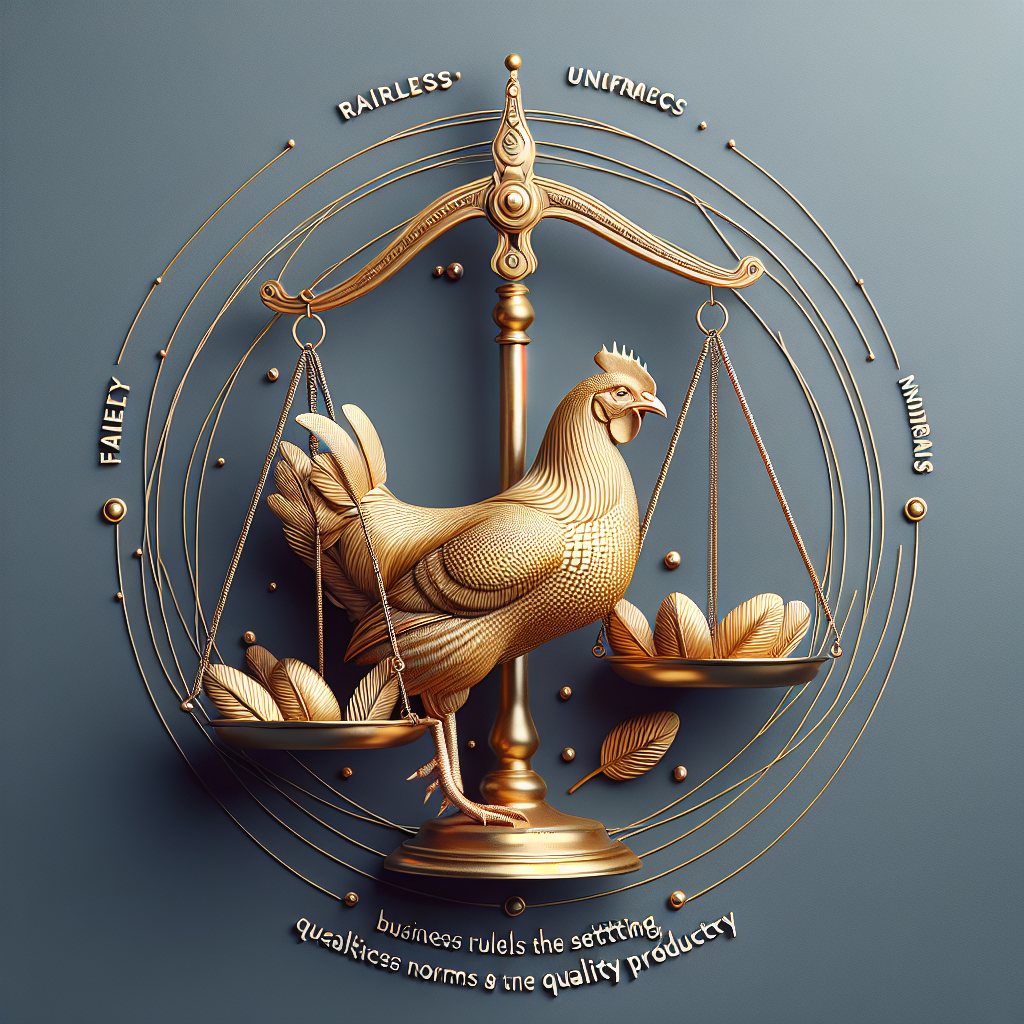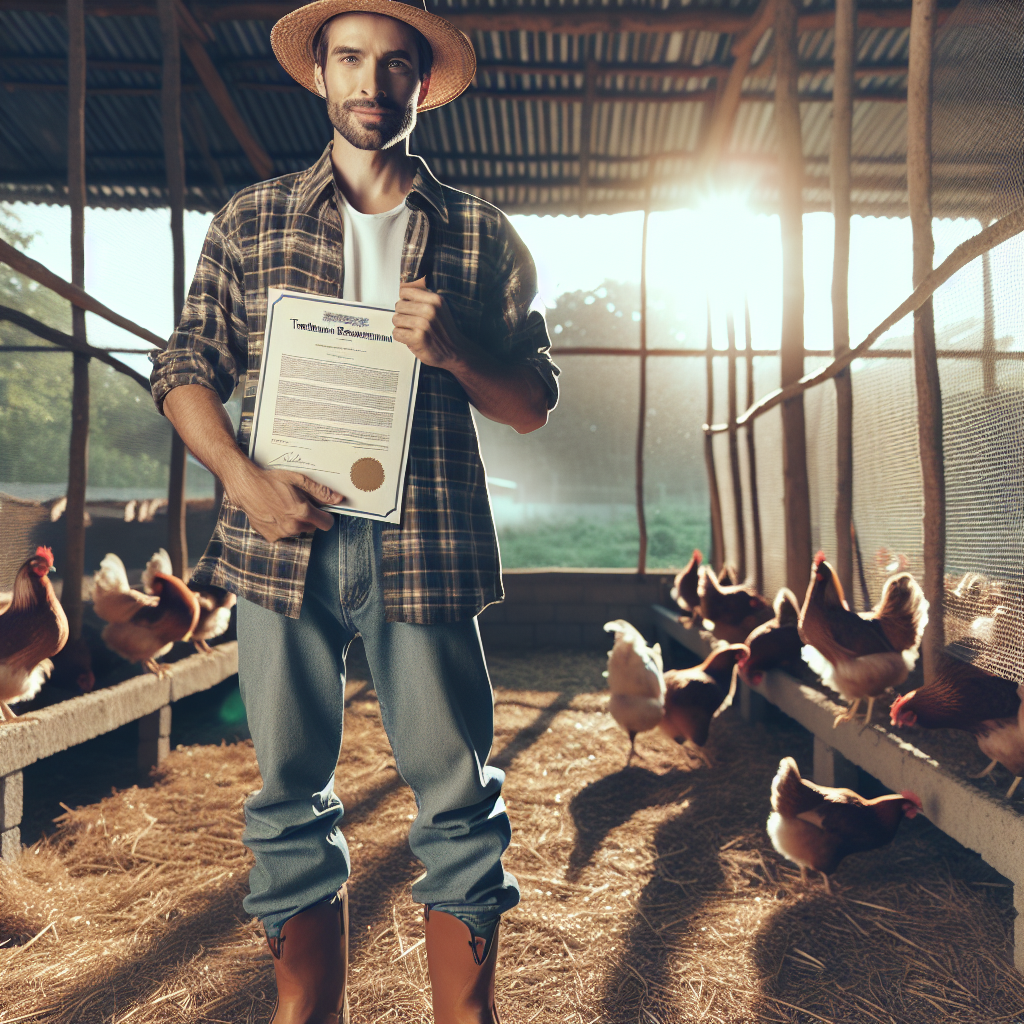Have you ever wondered how the quality standards for chicken products are determined? It’s all about the influence of business regulations. In this article, we will explore how these regulations play a crucial role in shaping the quality standards of chicken products. From ensuring food safety to promoting ethical practices, business regulations have a significant impact on the chicken industry. Let’s dive in and learn more about the intricate relationship between business regulations and the quality of chicken products.
Overview of Business Regulations in the Chicken Industry
Business regulations in the chicken industry play a crucial role in ensuring the safety and quality of chicken products. These regulations cover various aspects, including food safety, quality standards and specifications, farming practices, import and export regulations, traceability and recordkeeping requirements, advertising and labeling regulations, sanitary and packaging regulations, and worker health and safety regulations. Understanding and complying with these regulations is essential for businesses operating in the chicken industry to maintain high standards and meet consumer expectations.
Types of regulations
There are several types of regulations that govern the chicken industry. These include federal, state, and local regulations that address various aspects of production, processing, and distribution. Federal regulations are typically more comprehensive and set the baseline standards, while state and local regulations may provide additional requirements or variations to ensure compliance with specific regional needs. These regulations aim to protect public health, ensure fair competition, and promote consumer confidence in the chicken products they purchase.
Roles of government agencies
Government agencies have a critical role in enforcing and implementing regulations within the chicken industry. In the United States, the U.S. Department of Agriculture (USDA) and the Food and Drug Administration (FDA) are the primary agencies responsible for regulating the industry. The USDA’s Food Safety and Inspection Service (FSIS) oversees the safety and labeling of chicken products, while the FDA focuses on regulatory oversight of animal feed and veterinary drugs. Additionally, state and local health departments may have their own agencies responsible for enforcing specific regulations within their jurisdictions.
Impact on quality standards
Business regulations in the chicken industry have a direct impact on the establishment and maintenance of quality standards. These regulations set minimum requirements for chicken products, ensuring that they are safe for consumption and meet certain quality benchmarks. By implementing and enforcing these standards, regulators help prevent the sale of substandard or unsafe chicken products, protecting consumers from potential health risks. Furthermore, regulations also play a role in promoting consistency and uniformity in chicken products across the industry, fostering fair competition and consumer trust.
Food Safety Regulations
Food safety is of utmost importance in the chicken industry, given the potential risks associated with poultry consumption. Various food safety regulations are in place to address these concerns and protect consumers from foodborne illnesses. Two key regulatory frameworks in this regard are the implementation of Hazard Analysis Critical Control Point (HACCP) systems and poultry inspection programs.
Implementation of HACCP systems
HACCP systems are preventive management procedures designed to identify and control potential hazards in food production processes. In the chicken industry, businesses must implement HACCP systems to minimize the risk of contamination, pathogen growth, and other food safety hazards. These systems involve identifying critical control points, establishing control measures, monitoring procedures, corrective actions, and recordkeeping. By adhering to HACCP principles, businesses can effectively manage and mitigate food safety risks, thus ensuring the quality and safety of their chicken products.
Poultry inspection programs
Poultry inspection programs play a crucial role in safeguarding the chicken supply chain. The USDA’s FSIS is responsible for overseeing the inspection of poultry products to verify compliance with regulatory standards. This includes conducting both pre-slaughter and post-slaughter inspections, as well as inspecting processing facilities to ensure they meet sanitation requirements. By implementing comprehensive inspection programs, regulators can identify and address any potential issues that may compromise the safety and quality of chicken products.
Labeling requirements
Labeling requirements are another important aspect of food safety regulations in the chicken industry. Labels on chicken products must provide accurate and essential information to consumers, including product name, ingredients, allergen warnings, net weight, handling instructions, and contact information for the responsible party. Clear and informative labeling helps consumers make informed choices and enables them to avoid allergens or other substances they may be sensitive to. Moreover, proper labeling ensures traceability and accountability throughout the supply chain, facilitating prompt action in case of product recalls or safety concerns.
Quality Standards and Specifications
Quality standards and specifications are vital in maintaining the integrity and consistency of chicken products. These standards set forth specific requirements that businesses must adhere to in order to produce and sell chicken products of a certain quality.
Minimum requirements for chicken products
Regulations establish minimum standards that chicken products must meet to be deemed acceptable for sale. These requirements cover various aspects, including product composition, appearance, handling, storage, and safe handling instructions for consumers. For example, regulations may specify the maximum allowable levels of certain contaminants or the minimum required percentage of muscle meat in processed chicken products. Compliance with these minimum requirements ensures that consumers receive products that meet a certain quality baseline.
Grading and classification systems
Grading and classification systems provide a standardized way to categorize chicken products based on their quality characteristics. These systems typically involve evaluating factors such as meat color, texture, size, fat content, and overall appearance. The grading or classification assigned to a chicken product can influence its market value and help consumers make informed choices. For instance, the USDA grades poultry on a scale ranging from A to C, with Grade A representing the highest level of quality.
Specifications for processing and packaging
Regulations also outline specific requirements for processing and packaging chicken products. These specifications may include guidelines for temperature control during processing, packaging materials allowed, labeling requirements, and product handling practices. Regulations aim to ensure that processing methods maintain the quality and safety of chicken products while also preventing contamination, spoilage, or deterioration during distribution and storage.
Regulation of Chicken Farming Practices
The regulation of chicken farming practices encompasses various aspects such as animal welfare standards, environmental regulations, and safety and hygiene practices. These regulations are essential for promoting responsible and sustainable farming methods and safeguarding the health and well-being of both animals and consumers.
Animal welfare standards
Animal welfare regulations in the chicken industry aim to protect the rights and well-being of chickens throughout their lifecycle. These regulations set forth requirements for housing conditions, ventilation, space allocation, lighting, and access to food and water. They also cover guidelines for handling, transportation, and slaughter practices, ensuring that chickens are treated humanely and with care. Compliance with animal welfare standards not only promotes ethical practices but also helps prevent the spread of diseases and improve the overall health of chickens.
Environmental regulations
The chicken industry is subject to environmental regulations that address concerns related to waste management, water usage, air quality, and land use. These regulations aim to minimize the environmental impact of chicken farming activities by setting standards for proper waste disposal, nutrient management plans, and erosion control. By promoting sustainable farming practices, regulators strive to protect natural resources, biodiversity, and the overall ecological balance.
Safety and hygiene practices
Regulations governing safety and hygiene practices in the chicken industry ensure that farms and processing facilities maintain high standards of cleanliness and provide a safe working environment. These regulations cover areas such as personal hygiene, pest control, sanitation procedures, and equipment maintenance. Implementing proper safety protocols, including training employees on best practices and providing personal protective equipment, helps prevent injuries, minimize the risk of contamination, and ensure the overall safety and quality of chicken products.
Import and Export Regulations
Import and export regulations play a significant role in regulating the global trade of chicken products. These regulations focus on various aspects, including inspection and certification processes, international quality standards, and quotas and tariffs.
Inspection and certification processes
Import and export regulations require chicken products to undergo inspection and certification processes to ensure compliance with applicable standards. These processes involve verifying product safety, quality, labeling, and documentation accuracy. Inspections may be conducted by government agencies upon arrival or departure, or by accredited third-party organizations. Certificates issued as a result of these inspections provide assurance to importing countries and consumers that the products meet the necessary requirements.
International quality standards
International quality standards set out by organizations such as Codex Alimentarius or individual countries may also impact the import and export of chicken products. These standards define minimum requirements for the safety and quality of food products, including chicken. Adhering to international quality standards is crucial for businesses engaged in international trade to ensure market access and consumer confidence in the products they export.
Quotas and tariffs
Quotas and tariffs dictate the quantity and cost of chicken products that can be imported or exported. These measures are put in place by governments to protect domestic industries, control market supply, or address geopolitical considerations. Quotas limit the amount of chicken that can be imported or exported within a specified timeframe, while tariffs impose additional costs on imports or exports. Import and export regulations related to quotas and tariffs vary between countries and may significantly impact the profitability and competitiveness of businesses in the chicken industry.
Traceability and Recordkeeping Requirements
Traceability and recordkeeping requirements are essential for ensuring transparency and accountability within the chicken industry. These requirements involve maintaining documentation, tracking products, and establishing recall procedures to facilitate prompt action in case of safety concerns or product issues.
Documentation and reporting obligations
Regulatory requirements dictate that businesses in the chicken industry must keep records of their operations, including information on sourcing, processing, distribution, and labeling. These records enable authorities to trace the origin of chicken products, verify compliance with regulations, and take appropriate action in case of safety recalls or investigations. Businesses must ensure that their documentation is accurate, up-to-date, and easily accessible for inspection purposes.
Product tracking and recall procedures
Traceability regulations necessitate the implementation of product tracking systems, enabling businesses to identify and locate specific batches of chicken products at any point in the supply chain. These systems involve assigning unique identifiers, such as batch or lot numbers, to each product or product group. In the event of a safety concern or product recall, the ability to quickly identify and retrieve affected products is crucial for minimizing potential risks to consumers and maintaining the integrity of the brand.
Compliance audits and inspections
Regulators may conduct compliance audits and inspections to ensure businesses in the chicken industry adhere to traceability and recordkeeping requirements. These audits assess the accuracy, completeness, and effectiveness of documentation and the implementation of tracking systems. By conducting regular audits and inspections, authorities help enforce compliance, identify areas for improvement, and reinforce the importance of traceability and recordkeeping practices in maintaining safe and quality chicken products.
Advertising and Labelling Regulations
Advertising and labeling regulations aim to protect consumers from false or misleading claims and ensure that they have access to accurate and relevant information about chicken products. These regulations cover various aspects of advertising and labeling, including claims, nutritional information, and the labeling of genetically modified organisms (GMOs).
False or misleading claims
Regulations prohibit businesses from making false or misleading claims about their chicken products. This includes claims related to the origin, quality, safety, health benefits, or other attributes of the products. Businesses must ensure that their advertising accurately reflects the characteristics of the chicken products being marketed, providing consumers with reliable information to make informed choices.
Nutritional information requirements
Nutritional information requirements mandate that chicken products are labeled with accurate and complete nutritional information. This includes details such as the amount of calories, protein, fat, carbohydrates, vitamins, and minerals present in the product. By providing this information, consumers can make informed decisions about the nutritional content of the chicken products they purchase, particularly in meeting dietary or health-related needs.
Labeling of genetically modified organisms (GMOs)
Regulations addressing GMO labeling relate to the disclosure of genetically modified ingredients in chicken products. Depending on the region or country, regulations may require businesses to label products that contain GMOs or provide information on the absence of GMOs if the product is labeled “non-GMO” or “GMO-free.” These requirements aim to provide transparency and choice for consumers concerned about the use of genetically modified ingredients in their food.
Sanitary and Packaging Regulations
Sanitary and packaging regulations are crucial in ensuring the safety and quality of chicken products throughout the distribution process. These regulations establish guidelines for packaging materials and safety, storage and transportation, as well as sanitary facilities and equipment.
Packaging materials and safety
Regulations specify requirements for packaging materials used in the chicken industry to ensure they do not contaminate or compromise the quality of the products. Businesses must use packaging materials that are safe, suitable, and compliant with applicable regulations. Packaging should provide adequate protection against physical damage, microbial contamination, and temperature fluctuations. Ensuring proper packaging materials and safety measures helps maintain product integrity and extends the shelf life of chicken products.
Storage and transportation guidelines
Regulations provide guidelines for the proper storage and transportation of chicken products to minimize the risk of contamination, spoilage, or deterioration. These guidelines cover aspects such as temperature control, storage hygiene, handling practices, and separation to prevent cross-contamination. Businesses must comply with these regulations to maintain the safety and quality of the products during storage and transportation, preserving their freshness and minimizing potential risks to consumers.
Sanitary facilities and equipment
Sanitary facilities and equipment regulations dictate the design, construction, and maintenance of facilities and equipment within the chicken industry. These regulations cover areas such as processing plants, storage facilities, transport vehicles, and retail establishments. Businesses must ensure that their facilities and equipment meet specific hygiene standards, have proper cleaning and sanitation protocols in place, and provide adequate facilities for personal hygiene. Compliance with these regulations helps prevent contamination and supports the production of safe and high-quality chicken products.
Worker Health and Safety Regulations
Worker health and safety regulations are essential to protect employees involved in various aspects of the chicken industry. These regulations establish standards for occupational health and safety, training and certification requirements, and safety equipment and protocols.
Occupational health and safety standards
Occupational health and safety standards set forth requirements to protect workers from potential hazards in the chicken industry. These standards cover aspects such as machinery and equipment safety, ergonomics, chemical handling, noise control, and personal protective equipment (PPE). By implementing these standards, businesses aim to prevent workplace accidents, injuries, and illnesses, ensuring the well-being and safety of their employees.
Training and certification requirements
Regulations often require businesses to provide training programs to educate employees about safety procedures, equipment operation, and potential hazards in the workplace. These programs help promote a culture of safety, ensure employees are aware of their responsibilities, and equip them with the necessary knowledge and skills to perform their tasks safely. Additionally, businesses may need to meet certification requirements, demonstrating that their employees have undergone proper training and are competent in performing their assigned duties.
Safety equipment and protocols
Safety equipment and protocols are a vital aspect of worker health and safety in the chicken industry. Businesses are required to provide appropriate safety equipment, such as gloves, masks, aprons, and goggles, to protect workers from hazards such as chemical exposure or physical injuries. In addition, regulations mandate the implementation of safety protocols, such as emergency response plans, fire safety measures, and proper equipment maintenance. By ensuring the availability of safety equipment and adherence to safety protocols, businesses can prevent workplace accidents and protect the well-being of their employees.
Challenges and Future Developments
The chicken industry faces various challenges and opportunities for future developments that will shape business regulations and quality standards. These challenges include emerging technologies for quality control, adapting to changing consumer preferences, and international harmonization of regulations.
Emerging technologies for quality control
Advancements in technology, such as artificial intelligence, robotics, and data analytics, offer potential solutions for enhancing quality control in the chicken industry. These technologies allow for more accurate and efficient monitoring of production processes, inspection procedures, and traceability systems. By leveraging these technologies, businesses can streamline operations, optimize resource allocation, and ensure consistent adherence to quality standards.
Adapting to changing consumer preferences
Consumer preferences and demands are ever-evolving, which presents challenges for businesses in the chicken industry. Regulatory bodies will need to stay attuned to these changing preferences and ensure that regulations are adjusted accordingly. For example, regulations may need to address growing demand for organic or locally sourced chicken products or address concerns related to animal welfare and sustainability. By responding to changing consumer preferences, the chicken industry can remain relevant and meet the evolving expectations of consumers.
International harmonization of regulations
As the chicken industry becomes increasingly globalized, the need for international harmonization of regulations becomes more apparent. Harmonization efforts aim to align regulatory requirements and standards across different countries and regions, reducing trade barriers and facilitating international trade. By promoting harmonization, regulators can create a more level playing field and enable businesses to compete globally while ensuring consistent quality standards and consumer protections.
In conclusion, business regulations play a vital role in dictating the quality standards for chicken products in the industry. These regulations encompass various aspects, from food safety and quality standards to farming practices, import and export regulations, traceability requirements, advertising and labeling regulations, sanitary and packaging regulations, and worker health and safety standards. Compliance with these regulations is crucial for businesses to maintain high-quality standards, meet consumer expectations, and ensure the safety and integrity of chicken products. As the industry continues to evolve, challenges and future developments such as emerging technologies and changing consumer preferences will shape the regulatory landscape, driving the need for ongoing adaptation and international harmonization.




